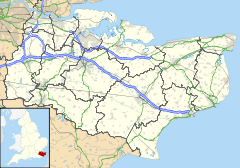Manston, Kent
| Manston | |
|---|---|
 War memorial and St Catherines church |
|
| Manston shown within Kent | |
| Population | 1,138 {2011} |
| OS grid reference | TR348662 |
| Civil parish |
|
| District | |
| Shire county | |
| Region | |
| Country | England |
| Sovereign state | United Kingdom |
| Post town | Ramsgate |
| Postcode district | CT12 |
| Dialling code | 01843 |
| Police | Kent |
| Fire | Kent |
| Ambulance | South East Coast |
| EU Parliament | South East England |
| UK Parliament | |
Manston is a village and civil parish in the Thanet district of Kent, England. The village is situated one mile north-west of Ramsgate. The parish includes four hamlets and the former Manston Airport.
The village was originally Mannestone which means 'farm on top of a hill' (a possible alternative variation is a farm belonging to a man called Mann) and was recorded in 1254 as Manneston, but obtained its modern spelling in 1381 around the time of the Peasants' Revolt.
The discovery of an Anglo-Saxon sword at what is known as the Ozengell burial ground and also 200 graves including a Roman stone and lead lined coffin, never preserved, show that the site has been occupied for many centuries.
In June 1381 the Peasants' Revolt reached Manston.
Two road names in the parish give clues to its past. Manston Court Road refers to Manston Court, the seat of the Manston family who held high office, including Richard de Manston at the time of King John (circa 1200) and William Manston, Sheriff of Kent in 1436; and Spratling Street gets its name from the Sprakling family who lived in Ellington in Ramsgate from 1558 to 1659, at a time when Manston was still a part of St Lawrence Extra.
Smuggling was rife in the Isle in the 17th and 18th centuries. Manston Cave, on the road towards Sandwich, was one of the smugglers' hideouts. Little of it now remains.
In 1901, the Isle of Thanet Poor Law Union opened a children's home at Manston. The homes comprised four pairs of houses and could accommodate a total of 120 children. In the 1901 census there were 46 inmates and the Superintendent was Edmund L Martins. One of the orphans, Frank Sidney Smith, an artist, painted a picture of Manston from memory in later life. This is now hanging in St Catherine's Church. The children's homes have now been converted to residential use. The orphanage's school is now the village hall.
...
Wikipedia

